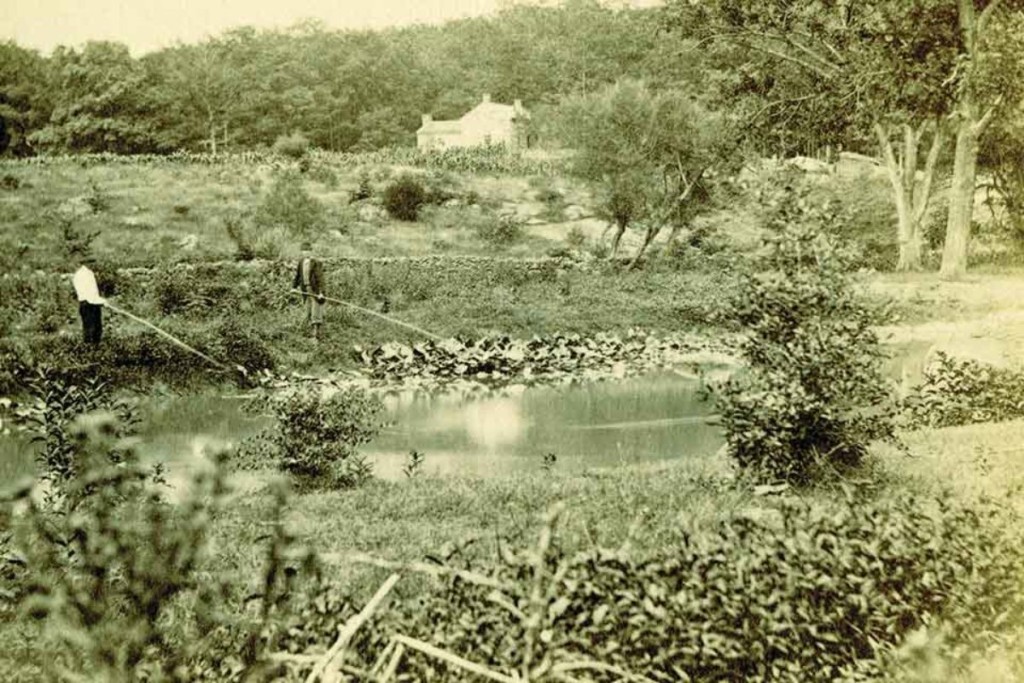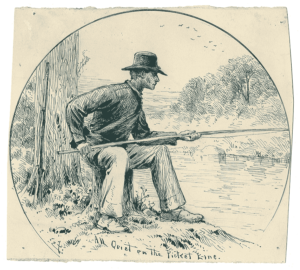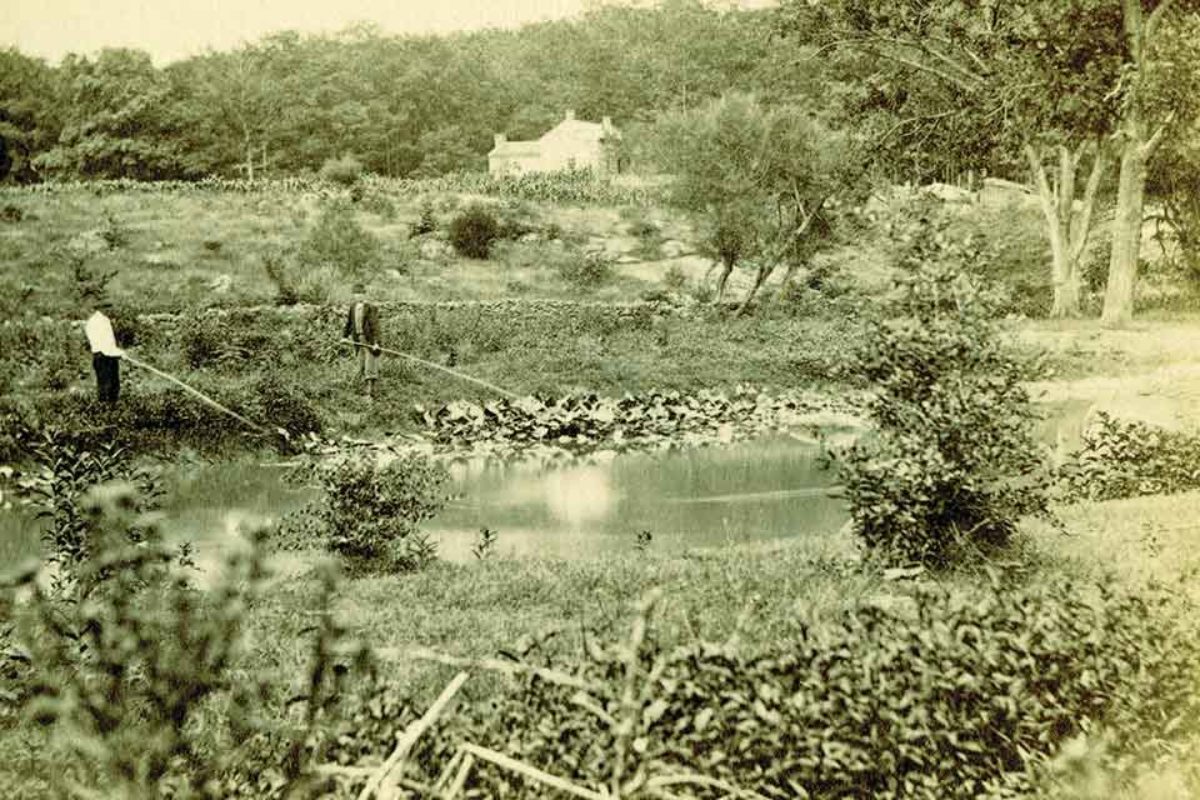Community Author: Brian E. Stamm

Students and scholars of the American Civil War have written extensively of camp life of soldiers on both sides during the conflict. Diaries, letters and other sources contain numerous references to card playing, gaming, reading and music while in camp. One activity that has been overlooked is that of soldiers fishing during down times. Fishing was not only a leisure activity for the common soldier but was also used as a way of supplementing their diets by adding a fresh alternative to army rations.

One may ask the question “How did a soldier accomplish the art of angling while on the march?” It would be impossible for any soldier to carry a fishing rod of any length along with the numerous articles of equipment required to perform his duty. Hooks, line and other accoutrements could easily be carried in a pocket or haversack and that is exactly what was done. Manufactured hooks came in various sizes depending on the type of gamefish desired and in one case a bent sewing needle was apparently utilized by an enterprising soldier outside of Gettysburg. Fishing line was also subject to availability and material. Braided horse hair, silk or a combination of both were common commercial types of line. However, soldiers would substitute heavy thread or cordage. The line could be handheld, tied to a “willow branch”, other stick or the use of a hand fishing tool. This tool was constructed of a thin piece of hourglass shaped wood about 4 inches in length and concaved at both ends to facilitate wrapping the line around it when not in use. 1


Left: Manufactured hook and hand fishing tools, c. 1860 Right: .58 caliber round and mini ball bullet sinkers – the lead was split by soldiers to facilitate their use; hook fashioned from a repurposed sewing needle, c.1860. Images courtesy of the author’s collection.
Lead weights or “sinkers”, used for ease of casting or getting the bait to sink would be made from bullets that where split open and then crimped on whatever line was utilized. “Bobbers” or “floats” made of wood, cork or even a piece of corncob were used to indicate a strike by a fish and tied somewhere above the hook at a desired length. Commercial bobbers where available at the time of the war however the substitutes worked just as well. As far as bait, worms where preferred. However, Lieutenant John Blue, of Company D, 17 th Virginia Cavalry wrote after the war that “crickets and bugs” worked just as well. 2
Typical species of fish that were sought after for eating were trout, catfish and eels. One soldier would pen during the war that he and his companions also sought sea turtles as a substitute for “fresh beef”. As far as fishing for sporting purposes, one individual stationed with the occupying Union forces in New Orleans caught a Gar in excess of 5 feet in Lake Pontchartrain. Another account by a Rhode Island Cavalryman, on board an ocean transport, reported that he and his comrades tied pieces of meat to strings attempting to entice a shark to latch on. 3

There are numerous accounts of soldier’s interest in fishing contained in letters, diaries and writings during and after the war. Lieutenant Frank Robertson of Confederate General JEB Stuart’s staff wrote home asking his wife to send him fishing lines and hooks. He even went as far as to draw on the letter the hook sizes he desired.
One drummer boy from the 10th West Virginia Infantry would write about “depopulating” a mountain stream of its supply of trout. Still another related the story of catching a large catfish in the Potomac River and sharing it with men from another unit. In one case, two Union prisoners would escape from their Confederate captors and would subsist on raw catfish before arriving in Union held territory. Even General Lew Wallace, the writer of the epic “Ben Hur” was a fishing aficionado. Wallace was so enthralled by the sport of angling, that after the war, he traveled extensively for that purpose and even invented several trawling hooks. 4
As one can see, soldiers on both sides used fishing to not only add to their diets, but also as a release from the boredom of camp life. Their writings that survive are proof that fishing was alive and well during the war. Perhaps, as they cast their lines into the fresh water streams throughout the interior or in the surf of ocean waters, each one reminisced about sitting along a quiet gurgling brook or farm pond at home. Fishing, for some, was quite possibly an escape from the horrors of war and brought a feeling of peace to their lives, if even for a few moments.
- Norris, Thaddeus, The American Anglers Book, pages 6 and 12. E.H. Butler and Co., Philadelphia, PA 1864; National Tribune, June 18, 1894, page 4.; Rutland Weekly Herald, May 22, 1862, page 4.
- Blue, John, Hanging Rock Rebel, page 185. Beidel Printing House, Shippensburg, PA 1994.
- National Tribune, July 25, 1907, page 6 and September 23, 1882, page 1.; The Potter Journal,
March 11, 1863, page 4.; William H. Stevens Letters, letter dated February 1, 1862, University of
North Carolina Archives. - Letter from Lieutenant Frank Robertson to his wife dated May 24, 1863, Wyndom Robertson Papers, University of Chicago
Archives.; National Tribune, September 23, 1882 page 1, December 18, 1890, page 4, June 18,
1894, page 4 and September 2, 1897, page 3.

About the Author
